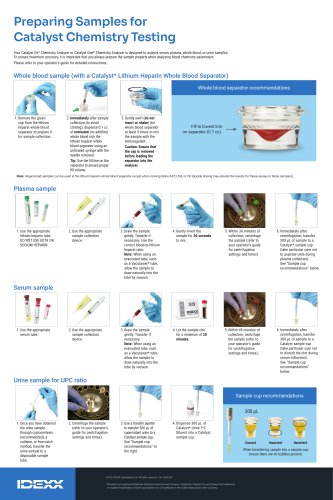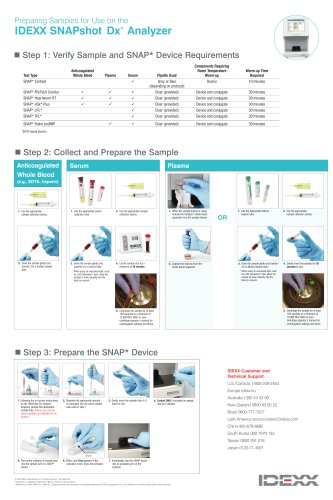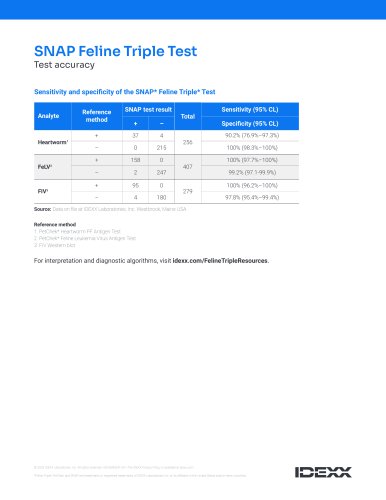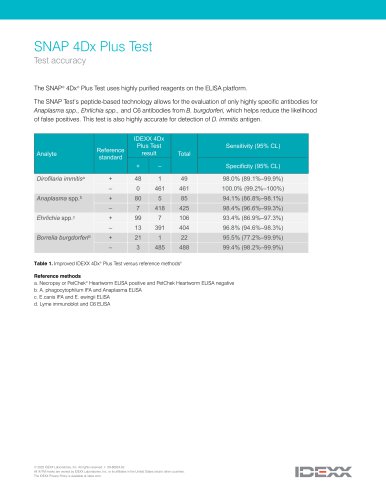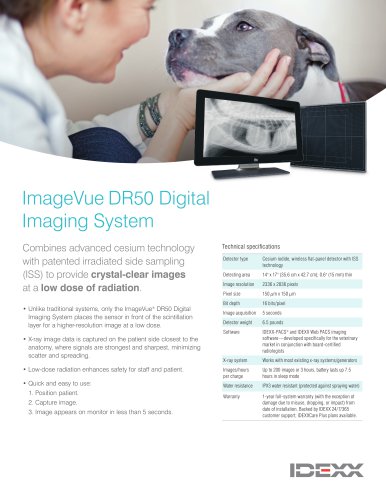
Catalog excerpts
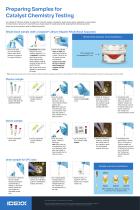
Preparing Samples for Catalyst Chemistry Testing Your Catalyst Dx* Chemistry Analyzer or Catalyst One* Chemistry Analyzer is designed to analyze serum, plasma, whole blood, or urine samples. To ensure maximum accuracy, it is important that you always prepare the sample properly when analyzing blood chemistry parameters. Please refer to your operator’s guide for detailed instructions. Whole blood sample (with a Catalyst* Lithium Heparin Whole Blood Separator) Whole blood separator recommendations 1. Remove the green cap from the lithium heparin whole blood separator to prepare it for sample collection. 2. Immediately after sample collection (to avoid clotting), dispense 0.7 cc of untreated (no additive) whole blood into the lithium heparin whole blood separator using an untreated syringe with the needle removed. Tip: Use the fill line on the separator to ensure proper fill volume. 3. Gently swirl (do not invert or shake) the whole blood separator at least 5 times to mix the sample with the anticoagulant. Caution: Ensure that the cap is removed before loading the separator into the analyzer. Whole blood separator recommendations Fill to lowest line on separator (0.7 cc). Note: Heparinized samples can be used in the lithium heparin whole blood separator except when running feline AST, LDH, or CK (double dosing may elevate the results for these assays in feline samples). Plasma sample 1. Use the appropriate lithium heparin tube. DO NOT USE EDTA OR SODIUM HEPARIN. 2. Use the appropriate sample collection device. 3. Draw the sample gently. Transfer if necessary. Use the correct blood-to-lithium heparin ratio. Note: When using an evacuated tube, such as a Vacutainer* tube, allow the sample to draw naturally into the tube by vacuum. 4. Gently invert the sample for 30 seconds to mix. 5. Within 30 minutes of collection, centrifuge the sample (refer to your operator’s guide for centrifugation settings and times). 6. Immediately after centrifugation, transfer 300 µL of sample to a Catalyst* sample cup (take particular care not to aspirate cells during plasma collection). See “Sample cup recommendations” below. 2. Use the appropriate sample collection device. 3. Draw the sample gently. Transfer if necessary. Note: When using an evacuated tube, such as a Vacutainer* tube, allow the sample to draw naturally into the tube by vacuum. 4. Let the sample clot for a minimum of 20 minutes. 5. Within 45 minutes of collection, centrifuge the sample (refer to your operator’s guide for centrifugation settings and times). 6. Immediately after centrifugation, transfer 300 µL of sample to a Catalyst sample cup (take particular care not to disturb the clot during serum collection). See “Sample cup recommendations” below. Serum sample 1. Use the appropriate serum tube. Urine sample for UPC ratio Sample cup recommendations 300 µL 1. Once you have obtained the urine sample through cystocentesis (recommended), a catheter, or free-catch method, transfer the urine sample to a disposable sample tube. 2. Centrifuge the sample (refer to your operator’s guide for centrifugation settings and times). 3. Use a transfer pipette to transfer 300 µL of supernatant urine to a Catalyst sample cup. See “Sample cup recommendations” to the right. 4. Dispense 300 µL of Catalyst* Urine P:C Diluent into a Catalyst sample cup. © 2024 IDEXX Laboratories, Inc. All rights reserved. • 06-18020-09 *Vacutainer is a registered trademark of Becton, Dickinson and Company. Catalyst Dx, Catalyst One, and Catalyst are trademarks or registered trademarks of IDEXX Laboratories, Inc. or its affiliates in the United States and/or other countries. When transferring sample into a sample cup, ensure ther
Open the catalog to page 1All Idexx Laboratories catalogs and technical brochures
Archived catalogs
-
IDEXX VetStat
86 Pages
-
Pseudalert
8 Pages
-
IDEXX SNAP 4Dx Plus
2 Pages
-
SNAPshot® DSR
2 Pages
-
ELISA Tips
1 Pages
-
Digital Imaging Brochure
10 Pages

